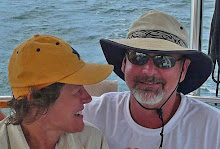 It was an overcast and rainy weekend; fortunately most of the projects on our list were inside the boat. We spent the weekend finishing up doing the maintenance on Gypsy’s seacocks. We’ve now disassembled, cleaned and lubricated all nine of them. Most of them were in hard-to-get-at places. The last one, for the head sink drain, was the worst. It took both of us working together to do it. In the process we had to remove the toilet to get the job done. We’ve always worked well together and lately were getting even better. We also replaced the primary and secondary Racor fuel filters along with the engine oil filter. The filters are located in difficult to access locations too but again we were able to work together to figure out the puzzles (eg; loosen the alternator to get the oil filter off) and get the job done.
It was an overcast and rainy weekend; fortunately most of the projects on our list were inside the boat. We spent the weekend finishing up doing the maintenance on Gypsy’s seacocks. We’ve now disassembled, cleaned and lubricated all nine of them. Most of them were in hard-to-get-at places. The last one, for the head sink drain, was the worst. It took both of us working together to do it. In the process we had to remove the toilet to get the job done. We’ve always worked well together and lately were getting even better. We also replaced the primary and secondary Racor fuel filters along with the engine oil filter. The filters are located in difficult to access locations too but again we were able to work together to figure out the puzzles (eg; loosen the alternator to get the oil filter off) and get the job done.Next we tackled the manual bilge pump. It’s a Whale Gusher 10 that I’ve been superstitious of from the begging. I like Whale pumps and have owned them before but I just wasn’t sure about this one. We filled the bilge and pumped away but nothing happened. So Susan crawled into the lazaret with a wrench and I worked above decks with a screwdriver and with the additional help of a hammer we got the beast un-mounted. Once free I worked the pump lever only to be rewarded with a big puff of dust in the face. Removing the main diaphragm revealed the source of the “dust”; lots of powered aluminum oxide in the body of the pump. I’ll clean, paint and rebuild it with all new valves and a new diaphragm this week.
 As we go through Gypsy’s systems one-by-one we’re not only cleaning, replacing and upgrading a lot of it, we’re gaining a very complete understanding on how Gypsy functions on the most basic level. It’s almost like Gypsy’s teaching us about herself.
As we go through Gypsy’s systems one-by-one we’re not only cleaning, replacing and upgrading a lot of it, we’re gaining a very complete understanding on how Gypsy functions on the most basic level. It’s almost like Gypsy’s teaching us about herself.Boat time – it’s a lot like island time, sometimes even slower. Right now we’re waiting for our rig to be completed by Hall Spars. Our rigging is 22 years old and needs to be replaced before we set out on our circumnavigation. We were planning on using this opportunity to switch from rod rigging to wire for two reasons; 1) We could easily get wire replaced in remote parts of the world which is not true of solid rod rigging and 2) wire is less expensive. As we got into the project we changed our minds about switching rigging types because the conversion was turning into an engineering project that, in the end, would probably cost as much as wire rigging. The engineering part of the conversion was the requisite retooling of the mast & spreader end fittings to accept the larger wire fittings. So that wiped out the cost advantage.
Rod rigging has a reputation for reliability which we hope will negate the advantage of wire rigging’s availability. Our reasoning is; if it doesn’t fail, we won’t have to replace it. The tropics, where we’re headed, are the harshest environment for a rigging. Because of rod rigging’s smooth surface, there’s no surface crevices where salt water can be trapped and lead to corrosion, so that’s a real advantage for us.
We took each other’s photos for our passport renewals. Before we started we studied the State Departments web page on passport photo requirements so we’d know what they’re looking for. The page show’s eight examples of solid US citizens photos that have been deemed acceptable to the government. We studied the sample photos carefully in order to understand just what we were supposed to look like in order to qualify. The first thing Susan noticed was that none of the examples were laughing, that could be a problem. She had to try real hard and eventually was able to pull it off.

 Me, I didn’t have to worry about uncontrolled laughter, I just tried hard not to break the camera.
Me, I didn’t have to worry about uncontrolled laughter, I just tried hard not to break the camera.167 days...

